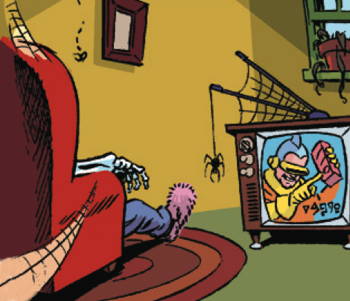April 2016
April 30, 2016
Insure It

Nick Hawk from the reality series Gigolos has insured his penis for $1 million dollars. I have heard of dancers insuring their legs and even sports professionals insuring various parts depending on what game and position they play. But usually those people are famous and talented. To be fair this show has been on for 6 years so Nick must be some what famous in certain circles. Hope the guy never has to collect though.
Posted By: Alex - Sat Apr 30, 2016 -
Comments (4)
Category:
LifeSkills Pod
Barclays Bank in the UK has created a "LifeSkills Pod" which it explains is a "futuristic work experience simulator" that mirrors "real-world work scenarios."Pods will be installed in various schools so that young people can sit in the pod and "build the skills needed in the workplace."

Posted By: Alex - Sat Apr 30, 2016 -
Comments (12)
Category: Jobs and Occupations, Technology
Hoesy Corona at Labbodies
LABBODIES: the pretentious gift that keeps on giving!
Posted By: Paul - Sat Apr 30, 2016 -
Comments (2)
Category: Ineptness, Crudity, Talentlessness, Kitsch, and Bad Art, Regionalism, Gender-bending
April 29, 2016
Small But Mighty
Watch this little bee pull a long nail out of brick. Pretty impressive, I doubt I could have removed it with a claw hammer and pliers!
Posted By: Alex - Fri Apr 29, 2016 -
Comments (5)
Category: Insects and Spiders, Natural Wonders
Cable Car Nymphomaniac
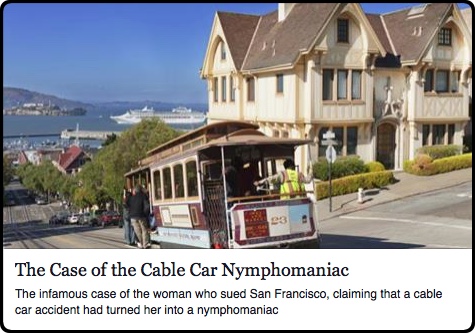
In 1964, a San Francisco cable car rolled partway down a hill before it came to an abrupt stop, causing a passenger, Gloria Sykes, to bang her head against a pole. Six years later, Sykes sued the railway, claiming that the accident had caused her to develop an "insatiable and uncontrollable desire for promiscuous sex." In other words, she had become a nymphomaniac.
The lawsuit is remembered to this day as one of the most bizarre cases in San Francisco's history. Here we take a closer look at it.
The Accident
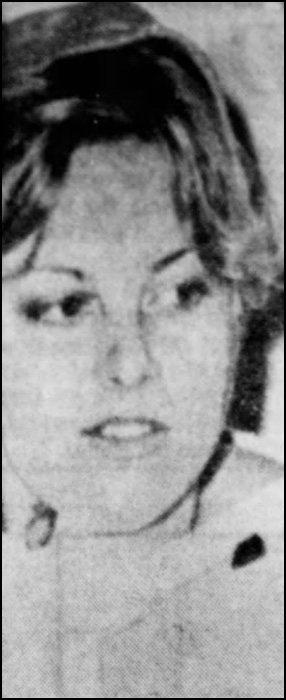
Gloria Sykes
The accident happened on September 29, 1964. Skyes was onboard a cable car, near the rear exit, as it climbed the steep Hyde Street incline, away from Fisherman's Wharf. About three-quarters of the way up the hill the cable grip suddenly failed, and the car started to slide backwards.
Thirty-six people were onboard. Sixteen of these managed to jump off the car as soon as they realized something was wrong. That left twenty people, including Sykes.
As the car rolled downhill, it quickly picked up speed, going faster and faster. Sykes screamed out, "Don't panic!"
The car rolled for almost three blocks before the gripman yanked on the emergency brake, causing the vehicle to come to an abrupt, shuddering halt. Passengers went sprawling onto the floor and slammed into seats. Sykes banged her head into a steel pole which, she later told a reporter, "I put a dent in."
Luckily, everyone survived in one piece, although many were banged up a bit. Sykes walked away with two black eyes and many bruises, but otherwise she seemed okay. However, "seemed" was the key word. Although the physical injuries soon healed, the emotional trauma did not go away as easily.
Sues For Damages
The next year, Sykes filed a lawsuit against the municipal railway, asking for $36,000 in damages on account of her injuries. However, her lawsuit got tied up in the legal system and remained unsettled.
So five years later, in 1970, Sykes filed a new suit (Gloria Sykes v. San Francisco Municipal Railway), and now she demanded much greater compensation, $500,000. Through her new lawyer, Marvin E. Lewis, she also introduced the dramatic claim that the accident had transformed her into a sex-addict.
The case, with its irresistible mix of an attractive woman and hypersexuality, immediately grabbed the attention of the media. Headline writers seemed to compete to come up with bad puns to describe it, such as "Sex Transit Gloria" and "A Streetcar-Blamed Desire."
Headline-Grabbing Details
During jury selection, Lewis summarized the case for the prospective jurors, telling them he would present evidence to prove that the 1964 accident had irrevocably changed Sykes's life. Sensational details from this summary soon made national news.
Before the accident, as Lewis told it, Sykes had been a deeply religious, strait-laced young woman — a Sunday school teacher and choir girl — but the accident had radically altered her, causing her to develop an "insatiable appetite for sex."
Lewis described how Sykes chose partners at random "when the vibrations were right." Her desire could be sparked by the "mere meeting of eyes while passing on a street." In the past year alone she had slept with over one hundred men, and recently her cravings for physical contact had begun to extend to other women.
However, said Lewis, these cravings had not been a source of pleasure for her. Instead, it had turned her life into a nightmare. Once trim-figured, she had gained over 20 pounds. She had contracted venereal disease (since cured), had had an abortion, and had even attempted suicide.
In addition, she had become a hypochondriac, imagining heart, lung, kidney, and back problems. All these problems made it difficult for her to keep a steady job.
According to Lewis, Sykes was a miserable woman, and all her miseries had started with the 1964 accident caused by the negligence of the railway.
Choosing The Jury
The lawsuit, in addition to sparking a media frenzy, represented a legal first. There had been previous cases where people had sued because an accident had caused a loss of sexual appetite (impotence or frigidity), but no one had ever sued because of increased sexual desire.
Lewis carefully screened the potential jurors to make sure that none of them had a problem with this central premise of the suit. He asked each one, "Could you believe a cable car accident could make a nymphomaniac of a proper, if attractive young woman?"
As it turned out, only one prospective juror indicated that this seemed implausible, and Lewis promptly dismissed her.
Eventually a full jury was selected, eight women and four men, and the trial was ready to proceed.
The Plaintiff's Case
The trial got underway in early April, 1970. It was presided over by Superior Court Judge Francis McCarty.
In making the case for why Skyes deserved $500,000 in damages, Lewis pursued two lines of argument. First, he brought in character witnesses — friends and acquaintances of Sykes — who testified about the change in her personality before and after the accident. Second, he used expert psychiatric testimony to try to persuade the jury about the reality and seriousness of Sykes's psychological condition.
One of the first to testify was a long-time female friend of Sykes who described how before the accident Sykes had been a "religious, upright girl," but afterwards had begun to have one affair after another.
The friend noted that she had once asked Sykes how she managed to meet so many men, and Sykes had responded that "it was easy. You just go up and talk."
The friend also revealed that Sykes had kept a diary, detailing all her sexual encounters. Despite this diary, Sykes often couldn't remember the last names "and sometimes even the first names" of her partners.
The existence of a tell-all sex diary immediately attracted the interest of the media. Lewis noted that he had received many offers from news organizations eager to print excerpts from it. However, the judge ruled that it had to be kept from the media until the end of the trial. (And it apparently never was published.)
As for the medical testimony, the jury heard from psychiatrists such as Drs. Andrew Watson and Meyer Zeligs, both of whom had concluded that Sykes was "getting no pleasure out of her numerous sexual relationships." Instead, they said, her promiscuity was the result of a search for security.
Lewis concluded by emphasizing to the jury his belief that Sykes suffered from a medical condition caused by the 1964 accident. She had, he said, "a neurosis that is no different from cancer or any other serious disease."
The Defense Responds
Deputy City Attorney William Taylor represented the municipal railway. From the start, he repeatedly dismissed as "unbelievable" the idea that a cable car accident could turn a woman into a nymphomaniac.
To undermine Sykes's case, he made three arguments.
First, he suggested that her nymphomania was caused not by the accident, but rather by birth control pills that she had started taking in 1965. The use of birth control pills, Taylor declared, could cause "promiscuity and unnatural sex drives."
Second, Taylor noted that Sykes had sexual affairs before the accident. Lewis conceded this was true, but insisted that "the episodes were few and were 'affairs of the heart.'"
Finally, Taylor brought in psychiatrist Dr. Knox Finley who testified that Sykes could have developed nymphomania without ever having been in an accident. Finley suggested that in Sykes's mind the accident had become a symbol on which she blamed every difficulty in her life.
Testimony of Sykes
During most of the trial, Sykes herself made no appearance. Lewis said that doctors had advised her that daily attendance would be too stressful.
But three weeks into the trial, towards the end, she finally showed up, took the stand, and testified for two-and-a-half days to a standing-room-only crowd.
Her testimony was surprisingly ambivalent. In response to a question from her lawyer about whether she thought the 1964 crash had given her an irrepressible sex urge, she said, "Mr. Lewis, I find it very difficult to believe that there's a connection between my cable car feelings and this sex urge. I don't know exactly what did it — a lot of things... that all worked together."
This mirrored pre-trial statements Sykes had made to reporters in which she expressed uneasiness about the nymphomania label. For instance, she had said, "I am not a nymphomaniac. After all I've been through I just needed a lot of affection, reassurance and security. And most men are not affectionate unless you become involved with them."
She had also said, "I feel so bad about this whole thing. I know how this must be hurting my family. But this emphasis on sex is all wrong."
These comments suggest that the legal strategy of focusing on her supposed "nymphomania" may primarily have been Lewis's idea, and Sykes only reluctantly weny along with it.
The Verdict
Before the jury left to deliberate, the judge issued a surprise directed verdict declaring that Sykes had suffered "some" injury as a result of negligence. Therefore, the only question left for the jury to decide was how much compensation she should receive. Lewis repeated the demand of $500,000, while Taylor suggested that a far lower number of $4500 would be reasonable.
The jury left the courtroom and came back with their answer eight hours later. Sykes, they said, would receive $50,000.
Headlines trumpeted the news: "Jury Rules Runaway Cable Car Caused Runaway Sex," "Sex-Starved Patient Gets $50,000."
But while it was true that Sykes had received an award, what the headlines failed to convey was that the size of the award was far less than what she had sought. Only one-tenth of it. And most of the award would have to go to legal fees, leaving Sykes with close to nothing.
In this sense, the verdict was not a victory for Sykes. The relatively small size of the award indicated that the jury must have been skeptical about the link between the cable car accident and Sykes's crowded sex life.
The defense attorney said he was "not unhappy" about the verdict.
Lewis tried to spin the outcome as positively as he could. He claimed the decision represented a "legal breakthrough" that established the principle of "psychic damages." But he simultaneously admitted he was disappointed with the amount of the award and said he might appeal. That never happened.
Aftermath
After the trial ended, the case no longer made front-page headlines, but interest in it endured. Throughout the 1970s, numerous references to the case continued to appear in news articles. Journalists often referred to it as the "cable car named desire" case.
There were two main reasons for the fascination with the case. First, it seemed to capture so much of the cultural tension surrounding the "sexual revolution" of the 1960s and 70s. Here was a modest, midwestern girl who moved to San Francisco and got swept up in a new, more hedonistic lifestyle, which ultimately proved too much for her. The case seemed to be as much about the sexual revolution, and the ongoing clash of cultures in America, as it was about a cable car accident.
Second, the case fed into concerns about an increase in frivolous lawsuits. Critics of American legal culture used it as a favorite example, summarizing it as the case of the woman who sued San Francisco claiming a cable car accident had turned her into a nymphomaniac — and won! This was true, but overlooked the fact that she won far less than she had sought. And the damages were for her injuries in general, not nymphomania specifically.
What happened to those involved in the case?
The lawyer, Marvin Lewis, continued to make headlines by specializing in unusual cases that often had a sexual theme. For instance, in 1973 he represented another once-devout woman turned sex-hungry nymphomaniac. His client, Maria Parson, sued a health club for $1 million, claiming that the experience of being locked inside a sauna room had caused her to develop multiple personalities, one of which was highly promiscuous. However, a jury declined to award her any damages.
Sykes dropped out of public view. A search of multiple news archives provides no information about what she did with her life after the trial.
However, interest in her story has continued to the present. So much so that in 2014 it achieved one of the highest honors a weird news story can earn. It got turned into a musical. The production, titled The Cable Car Nymphomaniac, debuted to positive reviews at San Francisco's Fogg Theatre.
Posted By: Alex - Fri Apr 29, 2016 -
Comments (8)
Category: Lawsuits, 1970s
App for Body Odor
Nivea has developed a smartphone app (called Nivea Men Nose) that will let men know if they have stinky body odor. The app also requires you use a special phone case that has sensors to detect body odor chemicals. To find out your B.O. level, you just hold the phone close to your armpit.I don't know why it's for men only. Perhaps male and female B.O. chemicals differ?
Also, seems to me that the people who worry enough about having B.O. to use this wouldn't be the people with really bad B.O. anyway.
Posted By: Alex - Fri Apr 29, 2016 -
Comments (8)
Category: Hygiene, Technology
Detroit 9000

Posted By: Paul - Fri Apr 29, 2016 -
Comments (6)
Category: Crime, Movies, Stereotypes and Cliches, 1970s
April 28, 2016
Wheaton College Mass Confessions
February 1950: During a chapel service, the students of Wheaton College were invited by the college president to come forward and confess their sins. What followed was 38 hours of uninterrupted confessions as one student after another came forward. Many confessed more than once. Classes were cancelled to allow the spontaneous confess-a-thon to continue.One student confessed that he wasn't sure if he loved his fiancee or God more, another to cheating in Bible class. A somewhat cynical student confessed that she couldn't believe all the confessions were sincere. Then asked forgiveness for doubting their sincerity.
Finally the college president halted the continuing stream of confessions, noting that "outsiders might think the revival has become too showy."
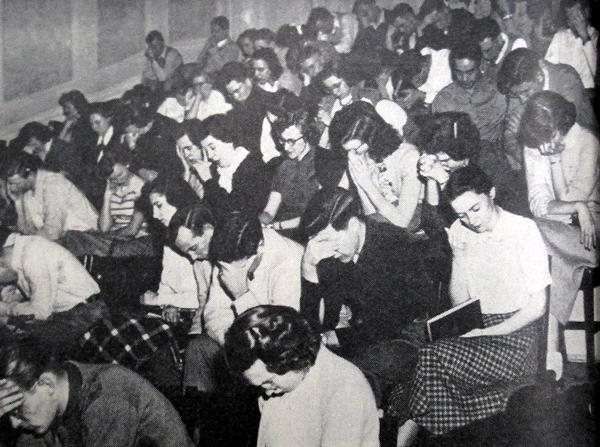
Wheaton students pray and listen to confessions
Newsweek - Feb 20, 1950
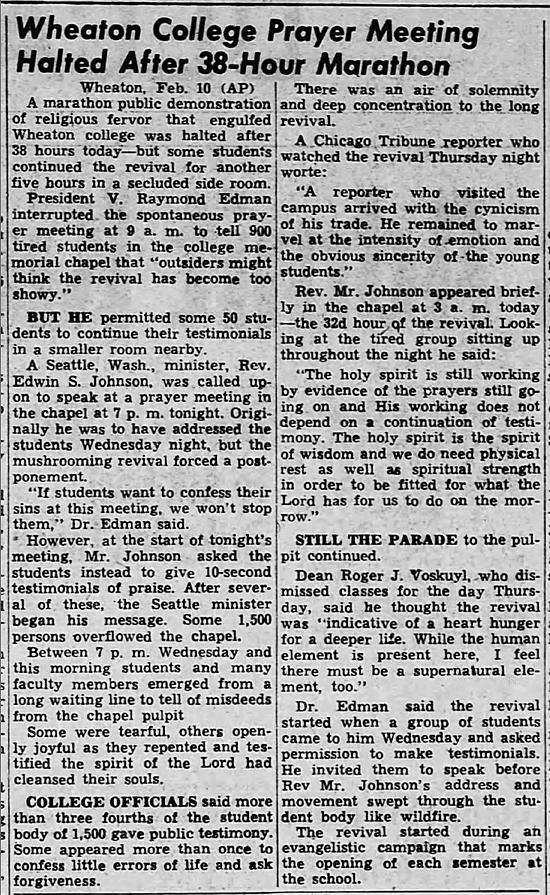
Decatur Herald - Feb 11, 1950
Posted By: Alex - Thu Apr 28, 2016 -
Comments (11)
Category: Religion, 1950s
Capturing Lions by Aeroplane
"The odor of gasoline indicates great wealth and to this they show due respect." So then: nothing has changed in the Middle East in nearly 100 years!
Cautionary note: numerous lions were hurt in the making of this film.
Posted By: Paul - Thu Apr 28, 2016 -
Comments (6)
Category: Animals, Hunting, Trapping and Other Wilderness Activities, Air Travel and Airlines, 1920s
April 27, 2016
Name Change
July 1959: Upon becoming a U.S. citizen, Turkish-born Haroutioun A. Aprahamian changed his name to Haroutioun A. Abrahamian.I know this got reported as weird news in the 1950s because it seemed like an odd twist on the phenomenon of immigrants Americanizing their names, but this guy probably just wanted to correct the spelling of his name which perhaps had been misspelled by an immigration official.
When my dad moved to the States from Germany in the 40s, our last name Böse got written as Boese, making it unpronounceable. My sister was smart enough to start spelling it as "Bose" from an early age (actually, whenever possible she insists it be spelled "Böse"), but I never did, so now I'm stuck with the unpronounceable spelling.
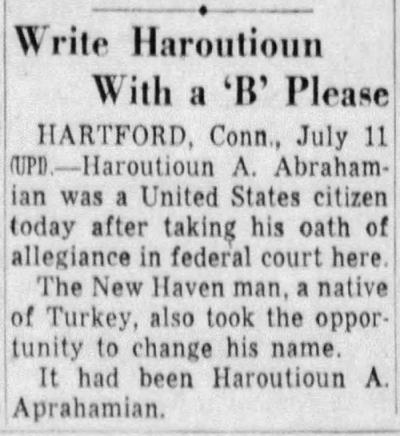
The Wilmington News Journal - July 11, 1959
Posted By: Alex - Wed Apr 27, 2016 -
Comments (10)
Category: Odd Names, 1950s
| Get WU Posts by Email | |
|---|---|

| Who We Are |
|---|
| Alex Boese Alex is the creator and curator of the Museum of Hoaxes. He's also the author of various weird, non-fiction books such as Elephants on Acid. Paul Di Filippo Paul has been paid to put weird ideas into fictional form for over thirty years, in his career as a noted science fiction writer. He has recently begun blogging on many curious topics with three fellow writers at The Inferior 4+1. Chuck Shepherd Chuck is the purveyor of News of the Weird, the syndicated column which for decades has set the gold-standard for reporting on oddities and the bizarre. Our banner was drawn by the legendary underground cartoonist Rick Altergott. Contact Us |
